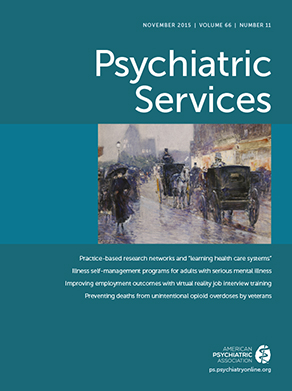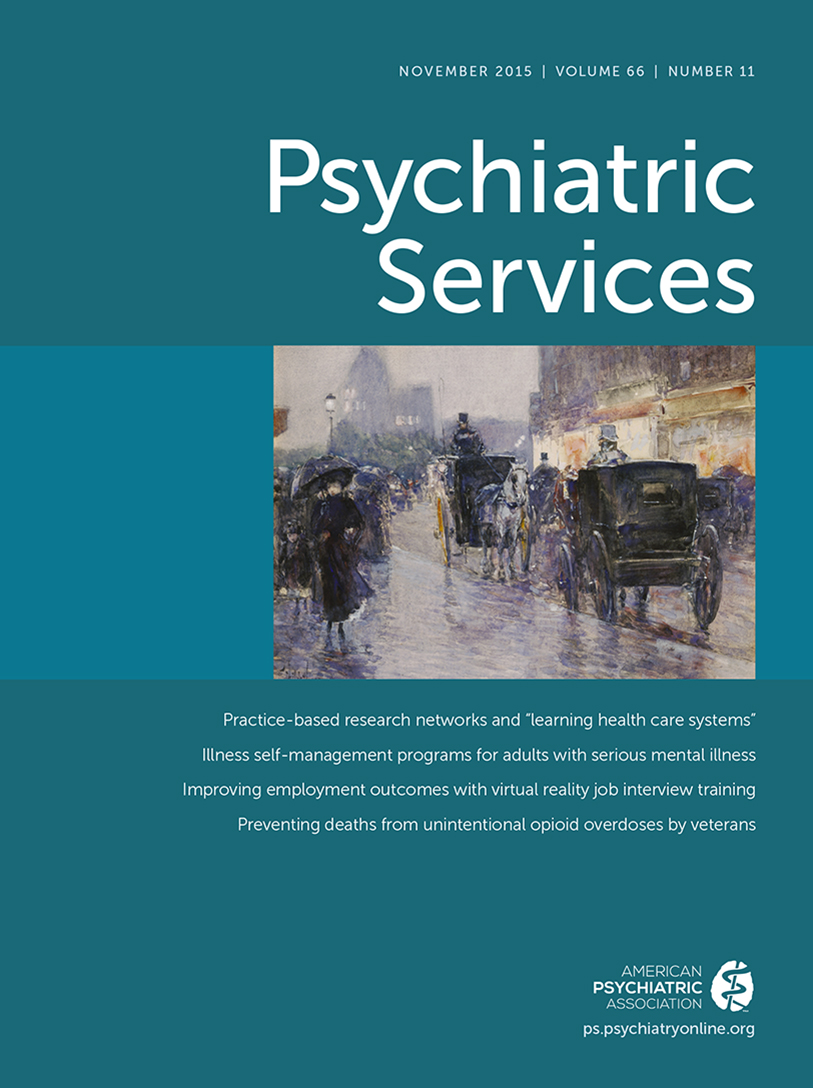Cognitive impairment and depression are common mental disorders among older adults, and they often co-occur (
1). Although cognitive impairment and depression independently contribute to the substantial burden of diseases and societal costs in the United States (
2,
3), it is unclear how the co-occurrence of the conditions affects functional outcomes and health services utilization. The co-occurrence of cognitive impairment and depression is estimated to double in frequency every five years after age 70 and affects at least one in four persons older than 85 (
1). Understanding the joint effect of cognitive impairment and depression is important, given that the cumulative effect of multiple conditions is likely to be more substantial than the effect of any one condition (
4). Moreover, having co-occurring conditions may complicate disease diagnosis and treatment.
This study examined the longitudinal association of co-occurring cognitive impairment and depression and onset of functional limitations, hospital and nursing home admissions, and out-of-pocket expenditures (OOPEs) in a nationally representative sample of middle-aged and older adults.
Methods
Individual-level data came from the Health and Retirement Study (HRS), a nationally representative longitudinal survey. The HRS is sponsored by the National Institute on Aging (grant NIA U01AG009740) and is conducted by the University of Michigan. Detailed information on the HRS survey design, questionnaires, and relevant data are available at a Web portal about the study (
hrsonline.isr.umich.edu). This study used data from seven waves of the HRS, covering a period from 1998 to 2010. Study participants included respondents from the following four study cohorts—the original HRS cohort, the 1993 Study of Assets and Health Dynamics cohort, and the Children of Depression and War Baby cohorts entering in 1998. After the exclusion of 1,687 proxy respondents and six participants with missing depression scores in 1998, a total of 18,315 age-eligible (51 or older) participants were included in the study sample and were followed for an average of 9.3 years. The HRS was approved by the University of Michigan Human Subjects Review Committee, and this study was determined exempt by the University of Illinois at Urbana-Champaign Institutional Review Board.
The HRS cognition tests were based on the Telephone Interview for Cognitive Status (
7). Consistent with Langa and others (
8), we constructed a composite score of cognitive functioning (range 0–27) by using ten-item immediate and delayed word recall tests, the serial 7’s subtraction test of working memory, and the backward-counting test to assess attention and processing speed. Cognitive impairment was defined as a score of 11 or below (
8).
Depression was measured by the eight-item Center for Epidemiologic Studies Depression Scale (CES-D) (
9). Participants are asked about having the following feelings during much of the past week—depressed, everything was an effort, sleep was restless, could not getting going, lonely, sad, enjoyed life, and happy. A score of 3 and above suggests elevated depressive symptoms. This cutoff score has a sensitivity of .71 and a specificity of .79 for predicting a major depressive episode (
9).
Participants were categorized in four mutually exclusive groups: no cognitive impairment or depression, cognitive impairment alone, depression alone, and cognitive impairment plus depression.
Two categories of functional limitations were examined: activities of daily living (ADLs), including bathing or showering, eating, dressing, walking across a room, and getting into or out of bed; and instrumental activities of daily living (IADLs), including using the phone, managing money, taking medications, shopping for groceries, and preparing hot meals. Functional limitation of a specific category was defined as having difficulty in performing at least one activity in that category.
Hospital admission was assessed by asking a participant whether he or she had had any overnight hospital stays in the past two years. Nursing home admission was assessed by asking a participant whether he or she had been a patient overnight in a nursing home, convalescent home, or other long-term health care facility in the past two years. OOPEs included self-reported expenses in the past two years for the following services: hospital and nursing home admissions; physician, dental, and outpatient visits; prescription drugs; and home health care and other special facilities. If a respondent did not provide an exact amount, unfolding bracket questions were asked. OOPEs were converted to 2010 U.S. dollars by using the Bureau of Labor Statistics Consumer Price Index–All Urban Consumers (
www.bls.gov/cpi/).
The regression analyses adjusted for the following covariates: age, sex, race-ethnicity (non-Hispanic white, African American, other race or multirace, and Hispanic), education (less than high school, high school, some college, and college graduate), marital status (married or partnered; separated, divorced, or widowed; and never married), household net wealth (four quartiles), current smoking status, body weight status as measured by body mass index, self-reported diagnoses of chronic conditions (hypertension, diabetes, stroke, heart disease, cancer, lung disease, and arthritis), and type of health insurance (public insurance only, any private insurance, and uninsured). The HRS performed imputations for missing data on cognitive status, OOPEs, and household wealth by using a multivariate, regression-based procedure. The imputed data were used in this study.
Mixed-effects logistic regressions were performed to estimate the relationship between cognition and depression status during the prior wave of the study and functional limitations, health services utilization, and OOPEs during the current wave of the study. Compared with a standard logistic model, a mixed-effects logistic model contains both individual fixed effects and random effects, allowing individual heterogeneity and correlation in unobserved characteristics over time (
10). Study samples for limitations of ADLs and IADLs consisted of participants who were free of functional limitation in ADLs and IADLs, respectively, during the prior wave. To account for the skewness in expenditures, individual mixed-effects Tobit regression was used to examine the longitudinal association of cognition and depression comorbidity and OOPEs. All statistical analyses were conducted by using Stata, version 11.2 SE.
Results
Participants were an average age of 65.3 years in 1998 and were predominantly non-Hispanic white (83.3%) and female (57.2%). At baseline, 11,620 (66.1%) participants reported neither cognitive impairment nor depression, 2,261 (10.8%) reported cognitive impairment only, 3,047 (16.5%) reported depression only, and 1,387 (6.6%) reported cognitive impairment plus depression. The four groups differed substantially in individual characteristics. Compared with their counterparts in all other groups, individuals with cognitive impairment plus depression were most likely to be African American or Hispanic, had the lowest education achievement and the least amount of household wealth, were least likely to be married or covered by any private health insurance, and had the most number of chronic conditions (all p values <.001). [A detailed summary of sample characteristics stratified by cognition and depression status is available as an online supplement to this article.]
Table 1 shows the results from the regression analyses. Compared with their counterparts without cognitive impairment or depression, the three groups with either condition alone or both conditions were significantly more likely to report onset of limitations of ADLs and IADLs, new hospital and nursing home admissions, and higher OOPEs, with the largest effects among individuals with both conditions. Cognitive impairment plus comorbid depression was associated with a three- to fourfold increase in the odds of ADLs (odds ratio [OR]=3.02), IADLs (OR=4. 1.53 18) and nursing home admission (OR=3.34); increased odds of hospitalization (OR=1.53); and an increase of $1,150 in OOPEs.
Discussion
Cognitive impairment and depression independently predicted functional limitations, hospital and nursing home admissions, and OOPEs. The estimated effects were largest among middle-aged and older adults with both conditions. These findings are consistent with previous studies. A number of studies have suggested that dementia and even milder forms of cognitive impairment can predict functional decline (
6), increase hospitalization (
3), and drive up total medical expenditures (
3) and OOPEs (
5). Similarly, depression has been associated with indicators of disability (
2,
6) and with greater utilization of general and specialty health care (
2). When examined together, the joint impact of the two conditions on functional and health outcomes has been shown to be greater than the effect of either condition alone (
4,
6).
The functional and socioeconomic consequences of cognitive impairment and comorbid depression should be of concern, given the growing number of older adults. Functional limitations strongly predict future needs for assisted living and long-term nursing care (
6), which are costly to individuals and heavily tax the health care system. Large OOPEs, on the other hand, increase the financial burden for patients and their families and may discourage patients from utilizing health services as needed (
5).
The co-occurrence of cognitive impairment poses significant clinical challenges in treating geriatric depression because of the intercorrelations of the two conditions and the heterogeneity of symptoms (
11). Cognitive impairment may precede depressive symptoms (
12); conversely, depression may cause cognitive deficits (
13). In some cases, cognitive impairment may persist following remission of active depression symptoms (
14). It is important for clinicians to differentiate cognitive deficits secondary to depression from depressive symptoms associated with the neurodegenerative process, given that this distinction has significant implications for treatment. When developing treatment plans, clinicians should also be aware of the influence of general medical comorbidities on cognition and depressive symptoms.
A few limitations of this study should be noted. Modeling results that are based on data from prospective observational studies should be interpreted as correlations rather than causations. The relationship between depression and functional limitations could have been bidirectional. Functional limitations may cause depressive symptoms. The cognition battery used did not assess the full range of cognitive functioning nor serve as a clinical diagnosis of cognitive impairment or dementia. The CES-D measures the number of depressive symptoms present in the past week, which can vary greatly from week to week. Because of the relatively low specificity of CES-D measures, depression ascertained by the CES-D may not meet the criteria for clinical depression. In addition, sociodemographic differences in patterns of attrition in the HRS (
15) could have introduced bias in coefficient estimates.

